The Most Interesting Joint in the World: Shoulder
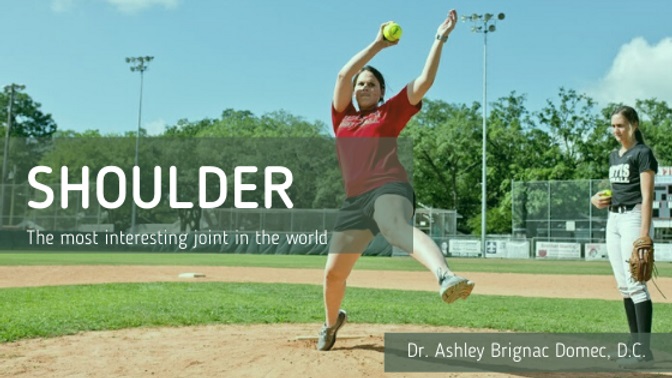
Imagine a part of the body that can move almost 360 degrees, be attached only by a small body, and be involved in almost any activity you do: that is the Shoulder! It is connected to the rest of the body by only 1 small AC joint. It can also move to over 16,000 positions differentiated by 1 degree for each position. Who knew? It also has no socket and relies on muscles more than any other joint in the body.
You can imagine then that the shoulder pain comes in all shapes and sizes, whether it’s a rotator cuff or labrum issue, biceps tendonitis, bursitis, or even frozen shoulder. We are here to simplify this amazing joint to you, as well as show you some of Dr. Domec’s favorite shoulder exercises.
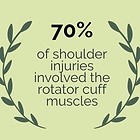
What is the shoulder joint? It is a ball-and-socket joint formed by the union of the humerus, shoulder blade (scapula), and the collarbone (clavicle). It is actually made up by 2 separate joints- the glenohumeral and acromioclavicular joints. These joints work together to allow the arm to move. It has numerous muscles and ligaments that are attached to it as well.
How many motions does it have? It is the most mobile joint in the body, being able to move to over 16,000 positions. It has 8 distinct movements: flexion, extension, abduction, adduction, horizontal abduction, horizontal adduction, internal rotation, and external rotation.
What injuries can chiropractic help with? We can treat a variety of conditions of the shoulder, whether is a postural or movement issue, muscle strains, inflammation, tears, tendonitis, or bursitis.
How can chiropractic help? Chiropractic can treat the shoulder with a variety of methods. First step is to properly evaluate and diagnose the cause of the problem. Adjustments of the neck and midback, as well as the scapula, clavicle, shoulder joint, and elbow can be utilized.
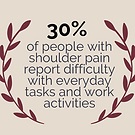
Soft tissue treatments, including cupping, deep tissue, instrument assisted, or pin and stretch are also available treatments. Dr. Domec’s favorite way to treat the shoulder is utilizing dry needling with stem attached. The improvement of various shoulder conditions with dry needling has been significant in the clinic and can help you!
Conditions you may not know that chiropractic can help with? You may already have an idea that chiropractic can help treat various movement problems of the shoulder or maybe you had no idea that we can help. We see many different injuries in our clinic, including but not limited to frozen shoulder, rotator cuff strain or tears, labral tears, biceps tendonitis, pec strain, bursitis, adhesive capsulitis, shoulder impingement, overuse/strains, arthritis, shoulder instability, mechanical issues (joint restrictions, postural abnormalities, irregular movement of the scapula), nerve pain, Thoracic Outlet Syndrome, etc.
How can I see if I am a candidate for Chiropractic? Email us (riverridgechiro@gmail.com), call us (504-738-7246), or go to our website
(www.riverridgechiro.net) to book an initial exam with Dr. Domec. She will take a detailed history and examination of your shoulder to diagnose the issue. She will then educate you on your specific problem and various treatments that will most benefit you. We can also schedule you for an initial consultation with Dr. Domec to see if you can benefit from chiropractic care. That visit includes a summarized history and postural analysis. Let us know if we can help you!

Bonus: Dr. Domec’s favorite shoulder exercises
ABCs against the wall
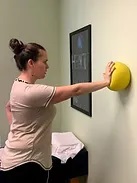
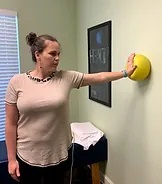
In two positions, forward facing and lateral (less than 90 degree angle), put a little weight into a soft ball against the wall. You want to start writing the ABCs with your hand without letting the ball fall. Perform 3 sets to burnout.
Bruegger’s Exercise
Seated or standing, perform without a band first. Elbows by your side, externally rotate the shoulders while bringing the shoulder blades together. Then extend your arm away from your body. Return slow and control to the starting position.
Cues: shoulder blade squeezes together. On the return, it feels like the shoulder blades are going into your back pocket.

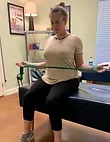
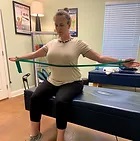
Prone T’s, Y’s, and I’s
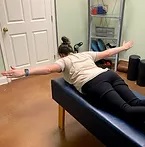
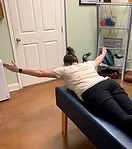
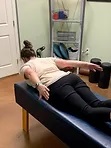
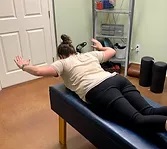
In 4 positions while laying prone (or at an incline), doing 3 sets of 10 second holds. In T’s, palms are facing the ground. In Y’s, thumbs are up. In I’s, thumbs are down. In the field goal position, palms are facing the ground. Perform body weight first. You can add 2.5 or 5 pounds once you are able to complete the full 3 sets for 10 seconds while maintaining the proper positioning.
Cues: squeeze shoulder blades together
Isometric External and Internal Rotation
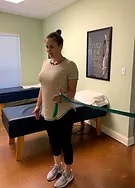
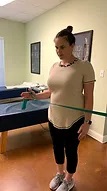
Unlike most internal or external rotation exercises where the shoulder or arm are moving, this exercise requires the arm to stay steady while moving your body. Starting position is elbow by your side and in a 90 degree position. Shoulder blade should be in a retracted position. With a band and in a slow and controlled, step away 2-3 steps and return. This increases the resistance in the band, while the arm remains in the same position and elbow by your side. Do each side 3 sets of 5 reps.
Exercise Tips:
- Slow and controlled is better than fast and sloppy.
- Make sure you are focusing on what the goal is and not just completing the set and rep total.
- Proper posture and positioning is very important in any exercise that you are completing.
- You can perform many exercises with body weight or resistance bands.
